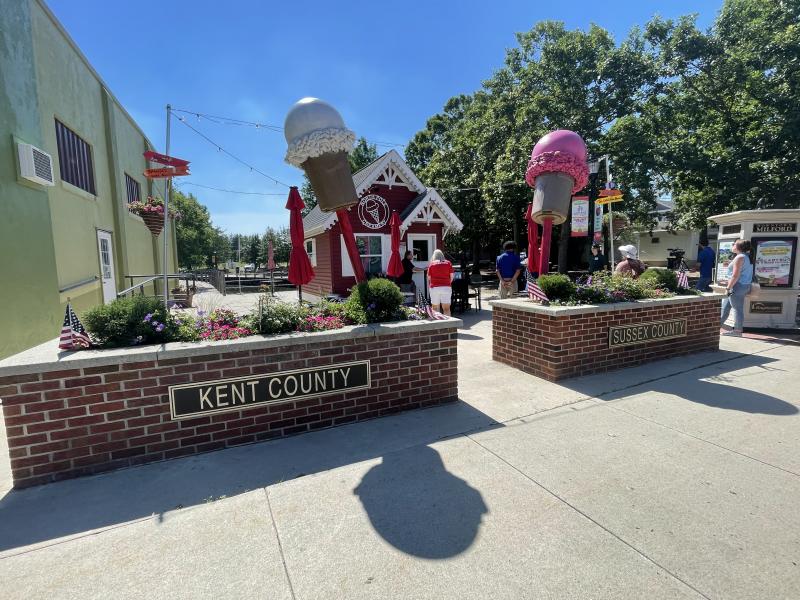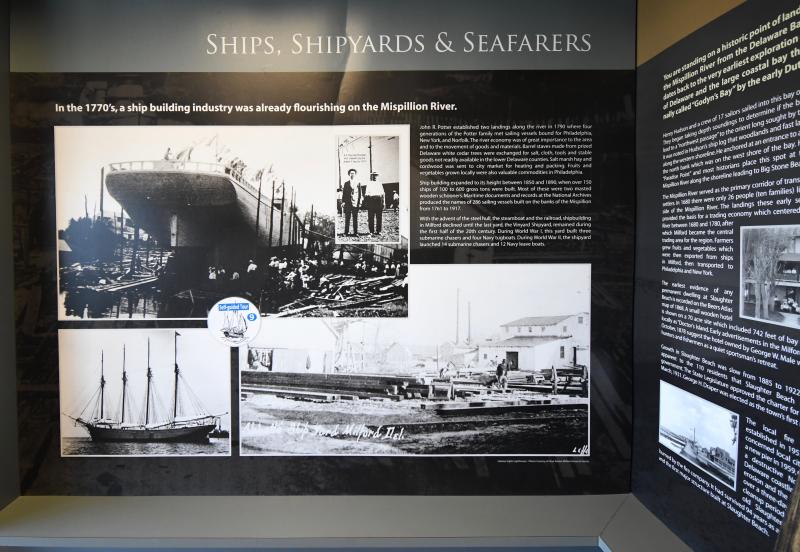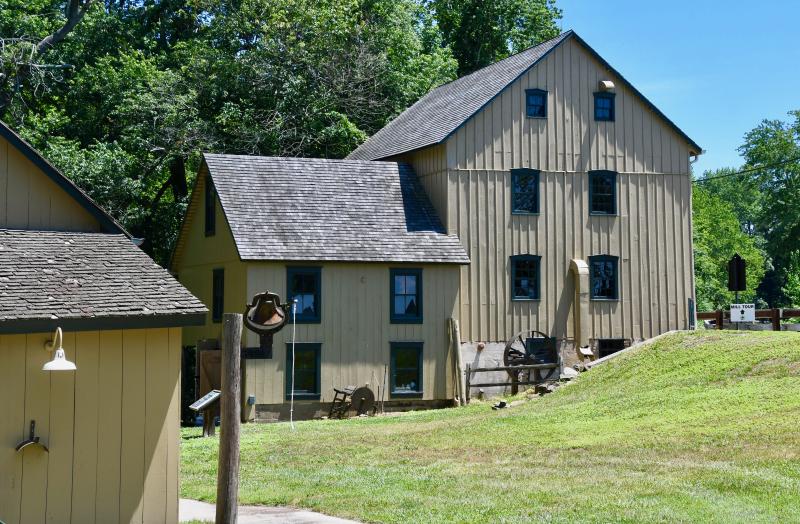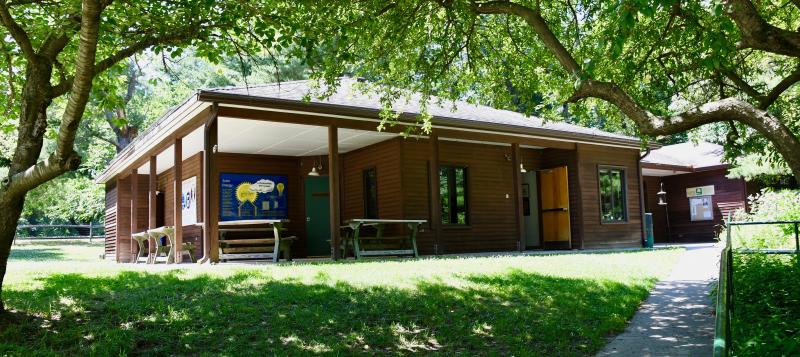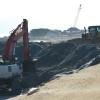Milford eco-tour highlights Mispillion River
Milford officials are working to capitalize on the city's rich history tied to the Mispillion River. The city grew up around the river thanks to the shipbuilding industry in the 18th and 19th centuries.
The Chamber of Commerce of Greater Milford has teamed up with Delmarva Discovery Tours to offer “A River Runs Through It: A History Eco-Tour Along the Mispillion” on Wednesdays, which includes the Milford Museum, a history walk and talk along the riverwalk, and trips to DuPont Nature Center at the mouth of the Mispllion and Abbott's Mill at the headwaters of the river.
Abbott's Mill is the last working grist mill in the area, while the DuPont Nature Center sits along the Delaware Bay, home to the largest population of spawning horseshoe crabs in the world.
Jo Schmeiser, director of the Milford chamber, said Lynne Pusey at the DuPont Nature Center reached out to her about a year ago.
“We've found folks wanting to get out more and thought it would be a great idea to bring visitors to Milford to showcase a few of our hidden outdoor gems along with the history of how these destinations are connected,” she said. “Milford is less than 30 miles from the resort beaches and, in addition to the unique destinations, has shopping and dining opportunities, and the tour provides time to checkout downtown, so investing a day in Milford is well worth the time.”
Milford's riverwalk
The Mispillion River, which is the border between Sussex and Kent counties, runs through Milford 16 miles to Mispillion Harbor and the Delaware Bay. William Penn established the boundary between Sussex and Kent and changed the original names of St. Jones County to Kent and Deale or Whorekill to Sussex.
The Lenape tribe was the first to discover what the river had to offer and made their summer camps along its shores. Nicole Rogers, of the Milford Museum, said the nomadic tribe feasted on large oysters from the river.
The earliest known Europeans sailed up the Mispillion in 1610.
In 1782, John Draper opened the first of many-to-come shipyards. In the mid-1800s, there were seven shipyards employing three-quarters of the town's workers. Rogers said hundreds of wooden sailing ships were launched from Milford in the 1800s.
In all, there were 18 documented shipyards and about 400 registered ships built along the Mispillion River.
Proximity to the Delaware Bay and abundant forests of white oak made Milford an ideal location to build ships.
The most prolific of the shipyards was the Vinyard Shipbuilding Company, which operated from 1896 to 1973. It's the last remaining shipyard in Sussex County thanks to the restoration efforts of Sudler Lofland, who purchased the property in 1966.
Milford has one of the most extensive riverwalks in Delaware, which also includes a two-mile greenway trail. A historic riverwalk loop tour of one-and-a-half miles passes by many of Milford's historic sites and homes.
The river is a good fishing spot and is perfect for kayaking and canoeing.
Horseshoe crabs, shorebirds
The DuPont Nature Center, located in the Mispillion Harbor Reserve at the end of Lighthouse Road near Slaughter Beach, is a short drive from downtown Milford. The center is owned and operated by the Delaware Division of Fish and Wildlife.
Cedar Creek and the Mispillion converge to create the Mispillion Harbor, which is an important access point for watermen and sports boats to reach Delaware Bay.
The aquatic education and interpretive center is designed to connect people with the Delaware Bayshore, said center manager Lynn Pusey. It includes an observation deck with spotting scopes and numerous exhibits devoted to the bay's natural history and ecology with a focus on spawning horseshoe crabs and the migratory shorebirds that visit the harbor every spring.
The center is open 10 a.m. to 4 p.m. Tuesday through Sunday from May 1 to Aug. 31. In April and September, it's open Wednesdays and Saturdays. The center is closed Oct. 1 to March 31.
One of nature's most spectacular events occurs on the shoreline around the center.
Pusey said Mispillion Harbor is one of the best places to view the annual horseshoe crab spawning and the subsequent landing of hundreds of thousands of migrating shorebirds, including the endangered red knot, that feed on the crabs’ eggs. She said Delaware Bay has the largest spawning population of horseshoe crabs in the world.
The peak time is from the middle to end of May. She said the birds typically leave after about two weeks after doubling their size on their way back to Arctic nesting grounds. Some of the birds travel 9,000 miles on their annual migration.
Last year's count estimated 31.3 million horseshoe crabs – 21.9 million males and 9.4 million females in the Delaware Bay area. DNREC officials said the count has been steadily increasing over the last decade.
The location where the center is located has changed over the years. The small spit of land once housed a restaurant and a fishing village complete with a lighthouse. Pusey explained that the history of the lighthouse is an interesting one with several rebuilds since it was first constructed in 1831. It was deactivated in 1929 and replaced with a metal structure. In 2002, it was destroyed by fire following a lightning strike.
Pieces of the lighthouse were purchased by Sally and John Freeman who used them to build a replica lighthouse as their home in Shipcarpenter's Square in Lewes.
Abbott's Mill: Step back in time
Abbott's Mill, located a short drive outside of Milford on Abbotts Pond Road, is truly a step back in time. At one time, there were more than 40 operating mills in Sussex County. Abbott's Mill, which has been completely restored, is the last remaining working mill in the region,
Steve Childers, an expert on mills, said every pond in the county was manmade and used to operate mills using water power.
Although a grist mill to make flour and feedstock at the location dates back to 1795, the restored mill of today was started by Ainsworth Abbott in 1919. He ran the mill as a one-man operation, except for deliveries, until he retired in 1963 at the age of 78.
The historic mill is part of the Abbott's Mill Nature Center in the 376-acre Milford Millponds Nature Preserve and operated by Delaware Nature Society. There is much more available at the center including hands-on nature education programs for people of all ages, trails, guided hikes, bird walks, summer camp, eco tours, a nature center and many events throughout the year, including Music at the Mill the second Thursday of each summer month from 6 to 8 p.m.
Guided tours of the mill are available on third Saturdays of the month from March through November. Admission is free to members and $5 to nonmembers.
The mill is owned by Delaware's Division of Fish and Wildlife and Division of Historical and Cultural Affairs and managed by the nature society.
For more information on the eco-tour, go to milfordchamber.com. Other information can be found at delmarvadiscoverytours.com, delawarenaturesociety.org and dnrec.alpha.delaware.gov/fish-wildlife/education-outreach/dupont-nature-center/.


